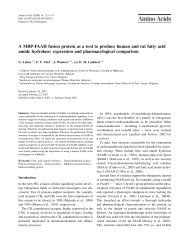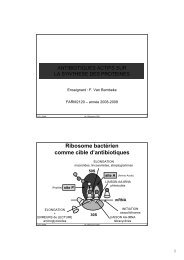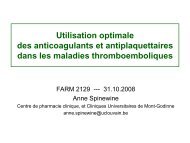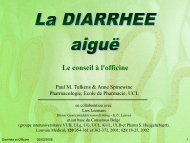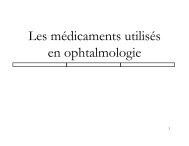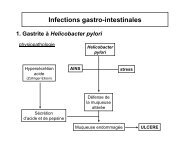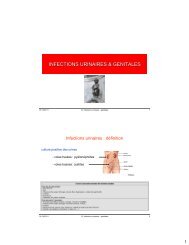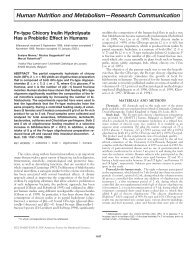Anémie / Neutropénie
anemie-neutropenie-2010.pdf
anemie-neutropenie-2010.pdf
Create successful ePaper yourself
Turn your PDF publications into a flip-book with our unique Google optimized e-Paper software.
<strong>Anémie</strong>-<strong>Neutropénie</strong> 2010<br />
1<br />
FARM 2129 : Pharmacologie spéciale<br />
<strong>Anémie</strong> /<br />
<strong>Neutropénie</strong><br />
Voir aussi Rang: Haematopoietic system
Classification des anémies<br />
<strong>Anémie</strong>s régénératives<br />
1. par déperdition sanguine aigüe<br />
2. hémolytiques<br />
<strong>Anémie</strong>s hyporégénératives<br />
1. insuffisance quantitative de l'érythropoïèse<br />
– érythroblasténies *<br />
– aplasie médullaire (par ex. sur certains médicaments)<br />
– envahissement médullaire (par ex. en cas de leucémie)<br />
2. insuffisance qualitative de l'érythropoïèse<br />
‣ insuffisance de synthèse de l'hémoglobine<br />
• carence en fer ou pertes sanguines chroniques<br />
• défaut de l'utilisation du fer *<br />
‣ insuffisance de synthèse de l'ADN<br />
• carence en vitamine B12<br />
• carence en folates<br />
type d'anémie<br />
normocytaire<br />
normochrome<br />
microcytaire<br />
hypochrome<br />
macrocytaire<br />
* observé dans des maladies infectieuses, inflammatoires et cancéreuses chroniques<br />
<strong>Anémie</strong>-<strong>Neutropénie</strong> 2010<br />
2
Les signes de l'anémie<br />
<strong>Anémie</strong>-<strong>Neutropénie</strong> 2010<br />
3
<strong>Anémie</strong>-<strong>Neutropénie</strong> 2010<br />
4<br />
Distribution et rôles biologiques du fer<br />
Molécules Localisation Teneur (g)* % Rôles biologiques<br />
hémoglobine sang 2.5 g 60 % transport de<br />
l'oxygène<br />
ferritine/<br />
hémosidérine<br />
foie, rate,<br />
moëlle<br />
osseuse<br />
1.3 30 % réserves de fer<br />
cytochromes<br />
et catalase<br />
cellules 0.025 0.5 % métabolisme oxydatif<br />
transferrine plasma 0.004 0.1 % transport du fer<br />
* pour un adulte de 70 kg<br />
Les réserves de fer sont très inférieures au fer circulant fonctionnel (hémoglobine)
<strong>Anémie</strong>-<strong>Neutropénie</strong> 2010<br />
5<br />
Mouvements du fer vers, dans, et à partir du corps<br />
fer alimentaire<br />
( 15 mg/jr)<br />
moëlle érythroblastique<br />
(150 mg)<br />
absorption limitée<br />
(1-2 mg/jr)<br />
fer plasmatique<br />
(transferrine)<br />
(3-4 mg)<br />
turn-over:<br />
25-30 mg/jr<br />
érythrocytes<br />
(3 g)<br />
foie / rate<br />
macrophages<br />
(1 g)<br />
pertes quasi exclusivement<br />
par les desquamation<br />
(peau et phanères, cell. intestin.):<br />
1-2 mg/jr<br />
Les capacités d'absorption et d'élimination du fer sont très faibles<br />
par rapport à la masse et aux mouvements intracorporels
<strong>Anémie</strong>-<strong>Neutropénie</strong> 2010<br />
6<br />
Absorption du fer - 1. contrôle intestinal<br />
• Iron homeostasis is regulated at the level of intestinal absorption<br />
• Iron is absorbed by villus enterocytes in the proximal duodenum<br />
• Efficient absorption requires an acidic environment (antacids or<br />
other conditions that interfere with gastric acid secretion can<br />
interfere with iron absorption)<br />
• Ferric iron (Fe +++ ) in the duodenal lumen is reduced to Fe ++ through<br />
the action of a brush border ferrireductase, and is cotransported<br />
with a proton into the enterocyte via the divalent metal transporter<br />
DMT-1 (which also transports many divalent metal ions.<br />
• Inside the enterocyte, iron follows one of two major pathways<br />
– Iron abundance states: iron within the enterocyte is trapped by incorporation into ferritin<br />
and hence, not transported into blood. When the enterocyte dies and is shed, this iron<br />
is lost.<br />
– Iron limiting states: iron is exported out of the enterocyte via a transporter (ferroportin)<br />
located in the basolateral membrane<br />
http://arbl.cvmbs.colostate.edu/hbooks/pathphys/digestion/smallgut/absorb_minerals.html<br />
Ce système de contrôle explique la limitation de l'absorption du fer, un excès de<br />
fer étant toxique étant donné sa lenteur d'élimination …
Absorption du fer –<br />
2. rôle de l'hepcidine<br />
(niveau systémique)<br />
Figure 1 Systemic iron homeostasis.<br />
Hepcidin controls the transferrin iron<br />
saturation by inhibiting iron efflux mainly from<br />
duodenal enterocytes and macrophages but<br />
also from hepatocytes. Its synthesis is<br />
positively regulated by the iron stores and<br />
negatively regulated by erythropoietic activity.<br />
Un trouble au niveau de cette régulation<br />
explique certaines formes d'hypersidérémie<br />
<strong>Anémie</strong>-<strong>Neutropénie</strong> 2010<br />
7
Pertes et besoins de fer (physiologiques / pathologiques)<br />
Situation<br />
perte moyenne<br />
(mg / durée)<br />
temps nécessaire<br />
pour compenser<br />
(mois) *<br />
facteur de<br />
sécurité **<br />
menstruations 20 / 3-4 jrs 0.7 1.4<br />
grossesse et<br />
accouchement<br />
700 / 9 mois 23 0.5<br />
lactation (6 mois) 700 / 6 mois 23 0.3<br />
don de sang (300 ml) 150 / 1 jr 5 ***<br />
pertes occultes sur<br />
saignement gastrique<br />
(3 ml/jr)<br />
50 / mois 1.6 0.65<br />
* pour une absorption nette de 1 mg de fer/jour<br />
** rapport apport alimentaire / perte sur un mois pendant toute la durée de la situation<br />
*** le don de sang s'accompagne d'un supplément de fer à pendre sur plusieurs semaines<br />
Plusieurs situations physiologiques ou pathologiques peuvent entraîner une<br />
déficience en fer souvent ignorée<br />
<strong>Anémie</strong>-<strong>Neutropénie</strong> 2010<br />
8
<strong>Anémie</strong><br />
ferriprive<br />
Anemia is a condition characterized by a bodily insufficiency of red blood cells, hemoglobin, or a combination<br />
of the two. A most common form is iron deficiency anemia, related to a paucity of the mineral iron, which the<br />
body requires to produce hemoglobin and transport oxygen.<br />
Without enough oxygen circulating in the body, symptoms such as extreme fatigue, pallor, weakness,<br />
lightheadedness, shortness of breath, and cold extremities may develop. Other possible signs of iron<br />
deficiency anemia include brittle nails, poor appetite, increased susceptibility to infection, headache, swelling<br />
and soreness of the tongue, and cracking of the sides of the mouth, though mild cases are sometimes<br />
asymptomatic.<br />
http://www.microscopyu.com/galleries/pathology/irondeficiencyanemiaexlarge.html<br />
<strong>Anémie</strong>-<strong>Neutropénie</strong> 2010<br />
9
<strong>Anémie</strong> ferriprive: populations à risque<br />
• population dénutrie<br />
(ou en manque de fer d'origine animale et/ou avec alimentation de qualité<br />
insuffisante<br />
• femme enceinte<br />
– constitution de la réserve fœtales<br />
• enfants<br />
– croissance (jeune enfant)<br />
– alimentation inadéquate (adolescents; jeunes filles)<br />
• patient âgé par diminution<br />
– de la réserve médullaire<br />
– de la réponse hormonale aux stimulants de l'hématopoièse<br />
– de l'apport alimentaire<br />
• cancer / inflammation / infections<br />
– "resistance" aux stimuli de l'erythropoietine<br />
http://www.microscopyu.com/galleries/pathology/irondeficiencyanemiaexlarge.html<br />
<strong>Anémie</strong>-<strong>Neutropénie</strong> 2010<br />
10
<strong>Anémie</strong>-<strong>Neutropénie</strong> 2010<br />
11<br />
Apports alimentaires en fer<br />
fer hémique<br />
This guy is wrong !<br />
fer "végétal"<br />
L'origine du fer (végétal vs<br />
animal) détermine sa<br />
biodisponibilité<br />
voir aussi:<br />
disponible<br />
sur i-campus
<strong>Anémie</strong>-<strong>Neutropénie</strong> 2010<br />
12<br />
Why is hemic iron more bioavailable ?<br />
because of the presence of a<br />
specific heme-transporter at the<br />
level of the intestinal cell villi<br />
What you need for optimal<br />
bioavailability of alimentary iron is this:<br />
myoglobin<br />
hemoglobin<br />
Dunn et al. Trends in Cell Biol 2006; 17: 93-100
<strong>Anémie</strong>-<strong>Neutropénie</strong> 2010<br />
13<br />
Oral iron with pharmaceutical preparations …<br />
All have a poor bioavailability (non hemic iron…)<br />
– May help if … you have a lot of time *<br />
thus, not in acute situations<br />
(ascorbic acid may help …)<br />
– treatment is ALWAYS long (3-6 months!!)<br />
All have several undesirable effects (you MUST warn the patient !!) due to presence of large<br />
amounts of free iron (that will not be reabsorbed)<br />
– irreversible teeth staining<br />
– diarrhea or constipation,<br />
– blackened stools (with persistent stains on clothes)<br />
– risk of ulcers (Iron sulfate) **<br />
Do NOT administer with drugs that may be complexed by dicationic or tricationic iron<br />
(diphosphonates, levodopa, fluroquinolones, tetracyclines, …) or which can reduce iron<br />
bioavailability (antacids, phosphates, calcium salts, …)<br />
* typical time to recover from a 300 ml blood loss: 1-2 months<br />
** see next slides
Iron sulfate and gastric ulcers…<br />
Zhang et al., Pathol Res Pract. 2009;205:579-81<br />
<strong>Anémie</strong>-<strong>Neutropénie</strong> 2010<br />
14
<strong>Anémie</strong>-<strong>Neutropénie</strong> 2010<br />
15<br />
Iron sulfate and esophageal ulcers…<br />
Areia et al., Endoscopy. 2007; 39 Suppl 1:E326
Préparations à base de fer (oral)<br />
<strong>Anémie</strong>-<strong>Neutropénie</strong> 2010<br />
16
Can iron be administered by the parenteral route ?<br />
A few milestones:<br />
‣ the early use of iron salts has been associated with very severe side effects (J. Clin.<br />
Invest. 1932; 11: 1293-1312 – N. Engl. J. Med. 1938; 219:910-912 – Blood 1946;<br />
1:129-142)<br />
‣ IV solutions with saccharose (sucrose) were found more acceptable (Lancet 1947;<br />
i:49-51)<br />
‣ Fisons introduced iron dextran in 1954, first for intramuscular (Lancet 1954; ii: 942)<br />
and later on for intravenous administration<br />
‣ Several other preparations of complexed iron have since then been introduced, with<br />
large variations between countries for commercialization<br />
The problems:<br />
• Complexation is often insufficiently stable leading to liberation of free, toxic ionic iron,<br />
causing oxidative stress …<br />
‣ iron saccharose (Venofer ® ) needs to be administered by small doses (100-200 mg) over<br />
several days<br />
• The complexing agent may cause severe adverse reactions<br />
‣ formation of anti-dextran antibodies<br />
‣ Iron-dextran needs to be administered very slowly (50 mg/min max.) and often over several<br />
hours<br />
<strong>Anémie</strong>-<strong>Neutropénie</strong> 2010<br />
17
<strong>Anémie</strong>-<strong>Neutropénie</strong> 2010<br />
18<br />
Préparations à base de fer: formes parentérales<br />
Warning box for Iron Dextran…<br />
• Anaphylactic-type reactions, including<br />
deaths<br />
• Use only in those patients with iron<br />
deficiency:<br />
Verified with lab tests<br />
Not amenable to oral iron therapy.<br />
• Resuscitation techniques and treatment of<br />
anaphylaxis and anaphylactoid shock must<br />
be readily available.<br />
Calcul de la quantité de fer à administrer<br />
• anémie par déficience en fer:<br />
mg Fe ++ = poids du patient [en Kg] x (100 - Hb [en % de la normale*]) x 0.14<br />
exemple: patiente de 60 kg avec Hb à 9 g% 336 mg<br />
• anémie par perte sanguine (hémorragie; don important de sang)<br />
mg Fe ++ = perte de sang (en ml) x hématocrite (en fraction décimale)<br />
exemple: perte de 1 litre donnant un hématocrite à 36 360 mg de Fe ++<br />
* 14.8 g/100 ml
<strong>Anémie</strong>-<strong>Neutropénie</strong> 2010<br />
19<br />
Surcharge en fer<br />
Situations typiques de surcharge en fer<br />
• hémosidérose par excès d'absorption<br />
(contrôle inadéquat de la résorption du fer [rôle de l'hepcidine<br />
hépatique])<br />
• transfusions répétées chez des patients anémiques mais sans<br />
pertes de sang (après hémolyse, ou thalassémies)<br />
l'hepcidine contrôle la<br />
libération du fer à partir<br />
des entérocytes<br />
(absorption) et des<br />
macrophages<br />
(recirculation) en<br />
fonction du taux de fer<br />
circulant
<strong>Anémie</strong>-<strong>Neutropénie</strong> 2010<br />
20<br />
Traitement de la surcharge en fer<br />
O<br />
O<br />
OH<br />
O<br />
N<br />
N<br />
H<br />
N<br />
H<br />
N<br />
N<br />
NH 2<br />
OH<br />
O<br />
O<br />
OH<br />
O<br />
1. déferoxamine<br />
HN<br />
O<br />
-O<br />
N<br />
(CH 2<br />
) 5<br />
NH 2<br />
Fe+++<br />
N<br />
O -<br />
-O<br />
N<br />
O<br />
O<br />
O<br />
N<br />
H<br />
N<br />
O<br />
OH<br />
2. déferiprone
Carences en vitamine B12 et en folates<br />
Vitamine B12<br />
1. défaut d'apport alimentaire (rare)<br />
2. troubles de l'absorption<br />
– manque de facteur intrinsèque (gastrectomie, maladie de Biermer)<br />
– atteinte de l'intestin grêle (sprue)<br />
3. par compétition intestinale (anse borgne, botriocéphale)<br />
Folates<br />
1. défaut d'apport alimentaire (patient âgé, situation de dénutrition)<br />
2. troubles de l'absorption (sprue, diarrhées chroniques)<br />
3. augmentation des besoins non rencontrée<br />
– grossesse et lactation<br />
– anémies hémolytiques<br />
4. éthylisme<br />
5. médicaments (agents antifoliques, antiépileptiques)<br />
<strong>Anémie</strong>-<strong>Neutropénie</strong> 2010<br />
21
Rôles de la vitamine B 12<br />
et de l'acide folique dans la synthèse du dTMP et<br />
influence du méthotrexate: vue générale<br />
méthotrexate<br />
provenant de l'<br />
acide folique<br />
alimentaire<br />
(par méthylation et réduction)<br />
Shorderet 1998 p. 670<br />
<strong>Anémie</strong>-<strong>Neutropénie</strong> 2010<br />
22
<strong>Anémie</strong>-<strong>Neutropénie</strong> 2010<br />
23<br />
Structure et absorption de la vitamine B 12<br />
H 2 N<br />
H 2 N<br />
O<br />
O<br />
H 2 N<br />
O<br />
O<br />
N<br />
N -<br />
N<br />
Co +++<br />
N<br />
O<br />
NH 2<br />
C -<br />
N<br />
O<br />
O<br />
NH 2<br />
La vitamine B12 (synthétisée exclusivement par des<br />
microorganismes) existe sous une forme liée (5'-<br />
deoxyadenosylcobalamine). L'hydrolyse a lieu dans<br />
l'estomac (acidité) et l'intestin (action de la trypsine) et la<br />
vitamine B12 libre doit ensuite se lier au facteur intrinsèque<br />
(une protéine sécrétée par les cellules pariétales de<br />
l'estomac).<br />
La vitamine B12 est stockée dans le foie (2-5 mg) pour un<br />
besoin journalier d'environ 1-5 µg.<br />
HN<br />
P<br />
O<br />
- O O<br />
HO<br />
O<br />
O<br />
OH<br />
N<br />
N<br />
NH 2<br />
Rôles essentiels<br />
• conversion de l'homocystéine en méthionine pour la<br />
transformation du N 5 -methyltetrahydrofolate en<br />
tétrahydrofolate<br />
• conversion du propionyl-CoA en succinyl-CoA (oxydation des<br />
ac. gras à nombre de impair de C et de la valine, de<br />
l'isoleucine et de la thréonine, via la méthymalonyl-CoA<br />
mutase)<br />
Les besoins journaliers en vitamine B12 sont très faibles par rapport au stock<br />
du corps. La carence ne s'observe guère qu'en cas de manque de facteur<br />
intrinsèque ou par détournement de la vitamine B12 par la flore intestinale
<strong>Anémie</strong>-<strong>Neutropénie</strong> 2010<br />
24<br />
Structure de l'acide folique<br />
O<br />
O<br />
OH<br />
O<br />
N<br />
H<br />
OH<br />
N<br />
O<br />
N<br />
N<br />
H<br />
H 2 N<br />
N<br />
N<br />
H<br />
polyglutamates<br />
(formes actives)<br />
ptéridine<br />
acide<br />
p-aminobenzoïque<br />
acide<br />
glutamique<br />
sulfamides…
<strong>Anémie</strong>-<strong>Neutropénie</strong> 2010<br />
25<br />
Absorption et distribution de l'acide folique et de ses dérivés à<br />
partir de l'alimentation<br />
L'acide folique alimentaire (polyglutamates)<br />
est converti en monoglutamate et passe<br />
ensuite par 4 réactions successives<br />
dihydrofolate<br />
tétrahydrofolate<br />
N 5 ,N 10 -méthylène-tetrahydrofolate<br />
N 5 -méthyl-tétrahydrofolate<br />
(L-methylfolate)<br />
Le N 5 -méthyl-tétrahydrofolate est la<br />
forme circulante qui sera reconvertie au<br />
niveau tissulaire en tétrahydrofolate par<br />
transfert du méthyle sur l'homocystéine<br />
(co-facteur: vitamine B 12 ), elle-même<br />
étant convertie en méthionine (donneur de<br />
méthyle pour toute une série de réactions)<br />
Les besoins journaliers en acide folique sont de 100 à 200 µg et le stock<br />
hépatique moyen n'est que de 10 à 20 mg (carence lente)
<strong>Anémie</strong>-<strong>Neutropénie</strong> 2010<br />
26<br />
Transformations de l'acide folique<br />
alimentaire (donneur de méthyle)<br />
(voir dia 25)<br />
3<br />
cell. intest.<br />
tissus<br />
acide folique<br />
acide dihydrofolique<br />
H 2N<br />
H 2N<br />
N<br />
N<br />
O<br />
N<br />
O<br />
N<br />
H<br />
N<br />
N<br />
H<br />
N<br />
N<br />
H<br />
N<br />
H<br />
N<br />
H<br />
O<br />
O<br />
O<br />
O<br />
N<br />
H<br />
O<br />
N<br />
H<br />
O<br />
OH<br />
OH<br />
OH<br />
O<br />
O<br />
OH<br />
OH<br />
acide tetrahydrofolique<br />
N<br />
O<br />
H<br />
N<br />
N<br />
H<br />
O<br />
O<br />
N<br />
H<br />
OH<br />
O<br />
OH<br />
H 2N<br />
N<br />
H<br />
N<br />
H<br />
N<br />
H<br />
OH<br />
O<br />
H 2 C<br />
N<br />
O<br />
-CH 3<br />
3<br />
ac. N 5 ,N 10 -methylène-tétrahydrofolique<br />
H2N<br />
HN<br />
N<br />
H<br />
N<br />
N<br />
H<br />
O<br />
O<br />
OH<br />
O<br />
CH 3<br />
N<br />
H<br />
OH<br />
ac. N 5 -methyl-tétrahydrofolique<br />
N<br />
N<br />
N<br />
H<br />
O<br />
H 2 N<br />
N<br />
H<br />
N<br />
H
<strong>Anémie</strong>-<strong>Neutropénie</strong> 2010<br />
27<br />
Transformations de l'acide<br />
tétrahydrofolique pour la synthèse du TMP<br />
(voir dia 22)<br />
O<br />
O<br />
OH<br />
acide tétrahydrofolique<br />
N<br />
O<br />
H<br />
N<br />
N<br />
H<br />
N<br />
H<br />
O<br />
OH<br />
inhibé par le<br />
méthotrexate<br />
sérine<br />
glycine<br />
H 2N<br />
N<br />
H<br />
O<br />
N<br />
H<br />
H 2 C<br />
N<br />
O<br />
O<br />
N<br />
H<br />
OH<br />
O<br />
OH<br />
2<br />
ac. N 5 ,N 10 -methylène-tétrahydrofolique<br />
H 2N<br />
HN<br />
N<br />
H<br />
N<br />
N<br />
H<br />
dUMP<br />
dTMP<br />
-CH 3<br />
1<br />
acide dihydrofolique<br />
N<br />
O<br />
N<br />
N<br />
H<br />
O<br />
O<br />
N<br />
H<br />
OH<br />
O<br />
OH<br />
H 2N<br />
N<br />
H<br />
N<br />
H
<strong>Anémie</strong>-<strong>Neutropénie</strong> 2010<br />
28<br />
Pourquoi le méthotrexate est-il un inhibiteur de<br />
la dihydrofolate réductase eucaryote ?<br />
O<br />
O<br />
OH<br />
O<br />
N<br />
H<br />
OH<br />
acide dihydrofolique<br />
N<br />
N<br />
N<br />
H<br />
O<br />
H 2N<br />
N<br />
H<br />
N<br />
H<br />
O<br />
O<br />
OH<br />
acide tétrahydrofolique<br />
N<br />
O<br />
H<br />
N<br />
N<br />
H<br />
N<br />
H<br />
O<br />
OH<br />
H 2N<br />
N<br />
H<br />
N<br />
H<br />
O<br />
O<br />
OH<br />
OH<br />
NH 2<br />
N<br />
H<br />
méthotrexate<br />
H 2 N<br />
N<br />
N<br />
N<br />
N<br />
N<br />
CH 3<br />
O
Pourquoi donner de l'acide folinique aux<br />
patients traités par le méthothrexate ?<br />
<strong>Anémie</strong>-<strong>Neutropénie</strong> 2010<br />
29
<strong>Anémie</strong>-<strong>Neutropénie</strong> 2010<br />
30<br />
Conversion de l'acide folinique en donneur<br />
de méthyle pour la synthèse du dTMP<br />
(vers réaction 1 à la dia 20)<br />
ac. N 5 -formyl-tétrahydrofolique<br />
(acide folinique)<br />
ac. N 10 -formyl-tétrahydrofolique<br />
H 2 N<br />
H 2 N<br />
N<br />
N<br />
O<br />
N<br />
H<br />
O<br />
N<br />
H<br />
N<br />
N<br />
H<br />
H<br />
N<br />
N<br />
H<br />
O<br />
O<br />
N<br />
H<br />
N<br />
O<br />
O<br />
O<br />
O<br />
N<br />
H<br />
O<br />
N<br />
H<br />
O<br />
N<br />
H<br />
OH<br />
OH<br />
OH<br />
O<br />
O<br />
OH<br />
OH<br />
OH<br />
O<br />
HC<br />
N +<br />
O<br />
ac. N 5 ,N 10 -méthényl-tétrahydrofolique<br />
H 2 N<br />
HN<br />
N<br />
H<br />
N<br />
N<br />
H<br />
O<br />
O<br />
N<br />
H<br />
OH<br />
OH<br />
O<br />
H 2 C<br />
N<br />
O<br />
ac. N 5 ,N 10 -methylène-tétrahydrofolique<br />
HN<br />
N<br />
H 2 N<br />
N<br />
H<br />
N<br />
H
Utilisations générales de la vitamine B 12 et de<br />
l'acide folique<br />
indications<br />
vitamine B12<br />
• carences<br />
(surtout signes neurologiques a<br />
ou abs. fact. intrins.)<br />
acide folique / ac. folinique<br />
• carences<br />
• prévention des effets<br />
toxiques des antifoliques b<br />
posologie<br />
• 0,1 à 1 mg ts les 2/3 jrs<br />
jusqu'à 6 mg puis 1 mg ts les 2<br />
mois<br />
• 0,5-2 mg/jr<br />
pdt 3-5 semaines<br />
• 1-5 mg/jr si méthotrexate<br />
effets indésirables • réact. anaphylact. • allergie<br />
• troubles gastriques<br />
voie d'administration<br />
• i.m.<br />
(en principe toujours ... mais )<br />
• p.o. ou parentérale<br />
a<br />
les signes neurologiques sont consécutifs à un trouble de la myélinisation due à<br />
l'accumulation de méthymalonyl-CoA (compétition avec le malony-CoA pour la synthèse<br />
des ac. gras et incorporation en tant que tel donnant naissance à des ac. gras branchés)<br />
b<br />
ac. folinique administré et quelques heures après le méthotrexate<br />
<strong>Anémie</strong>-<strong>Neutropénie</strong> 2010<br />
31
<strong>Anémie</strong>-<strong>Neutropénie</strong> 2010<br />
32<br />
Disponibilité de la vitamine B 12<br />
La cyanocobalamine et l’hydroxocobalamine sont disponibles sous forme de matière<br />
première pour les préparations magistrales; elles sont disponibles pour<br />
l’administration parentérale sous forme de médicament préfabriqué (cyanocobalamine<br />
disponible p. ex. en ampoules de 1 mg/1 ml par conditionnements de 3 ou 10<br />
ampoules; hydroxocobalamine disponible p. ex. en ampoules de 10 mg/2ml par<br />
conditionnements de 3 ampoules).
Disponibilité de l'acide folique et de l'acide folinique<br />
<strong>Anémie</strong>-<strong>Neutropénie</strong> 2010<br />
33
<strong>Anémie</strong>-<strong>Neutropénie</strong> 2010<br />
34<br />
Myélopoièse<br />
Rang 2003
Erythropoiétine : physiologie<br />
<strong>Anémie</strong>-<strong>Neutropénie</strong> 2010<br />
35
<strong>Anémie</strong>-<strong>Neutropénie</strong> 2010<br />
36<br />
Erythropoiétines<br />
• Action via les thyrosine-kinases pour provoquer la<br />
maturation des cellules souches en érythrocytes<br />
Burst-Forming-<br />
Units E =<br />
earliest cells<br />
committed to<br />
form<br />
erythrocytes<br />
Colony-<br />
Forming-<br />
Units E =<br />
"committed<br />
erythroid<br />
progenitor"
<strong>Anémie</strong>-<strong>Neutropénie</strong> 2010<br />
37<br />
Erythropoiétines<br />
• l'érythropoiétine agit au stade final de la différentiation/maturation mais<br />
a son action inhibée par divers facteurs en relation avec l'inflammation<br />
et le cancer; l'insuffisance rénale diminue sa production…
<strong>Anémie</strong>-<strong>Neutropénie</strong> 2010<br />
38<br />
Erythropoiétines: usages et mésusages<br />
• Traitement de l'anémie de l'insuffisant rénal chronique et<br />
du patient cancéreux<br />
• mais augmente le risque de toxicité cardiovasculaire<br />
(arrêt cardiaque, arrythmies, infrctus, attaques<br />
cérébrales, oedèmes, hypertension, insuffisance<br />
cardiaque congestive, thrombose)<br />
ne pas administrer en cas d'hypertension ou de<br />
trouble hématologique<br />
• potentiel d'abus par les athlètes (a conduit à la disqualification de<br />
skieurs de fond (Larisa Lazutina, Olga Danilova, Johann Mühlegg) et de<br />
nombreux cyclistes)
<strong>Anémie</strong>-<strong>Neutropénie</strong> 2010<br />
39<br />
Erythropoiétines<br />
chez les patients<br />
cancéreux:<br />
évidences<br />
pour la réponse<br />
hématologique<br />
Health Technology Assessment<br />
2007; Vol. 11: No. 13
<strong>Anémie</strong>-<strong>Neutropénie</strong> 2010<br />
40<br />
Erythropoiétines<br />
chez les patients<br />
cancéreux:<br />
évidences pour la<br />
survie<br />
Health Technology Assessment<br />
2007; Vol. 11: No. 13
Darbépoiétine<br />
• Darbepoetin alfa: a synthetic form of erythropoietin, produced by<br />
recombinant DNA technology in modified Chinese hamster ovary cells.<br />
It differs from endogenous erythropoietin by containing two more N-<br />
linked oligosaccharide chains than the natural protein, which<br />
increases its lifetime, reducing thereby the frequency of injections.<br />
• Indications are:<br />
– Treatment of anaemia associated with chronic renal failure in adults and<br />
paediatric subjects ≥ 11 years of age.<br />
– Treatment of symptomatic anaemia in adult cancer patients with nonmyeloid<br />
malignancies receiving chemotherapy.<br />
• Studies have extended these findings to treatment of patients<br />
exhibiting cancer-related anemia (distinct from anemia resulting from<br />
chemotherapy) but this is now disputed...<br />
<strong>Anémie</strong>-<strong>Neutropénie</strong> 2010<br />
41
Granulocyte-stimulating factor (G-CSF): usages<br />
• neutropénie induite par un traitement cytostatique ou immunosuppresseur;<br />
• certains cas de neutropénie idiopathique ou congénitale;<br />
• transplantation de moelle osseuse.<br />
• L'objectif est de réduire le risque et la durée des infections en augmentant<br />
le nombre de neutrophiles.<br />
Viret et al. , G-CSF et oncologie, Bull Cancer. 2006;93:463-71.<br />
disponible sur i-campus<br />
<strong>Anémie</strong>-<strong>Neutropénie</strong> 2010<br />
42
Granulocyte-stimulating factors<br />
• formes "normales"<br />
• formes pégylées *<br />
Veronese et al. Drug Discovery Today 2005;10-1451-1458<br />
PEGylation is the process of covalent attachment of poly(ethylene glycol) polymer chains to another<br />
molecule, such as a therapeutic protein. This can "mask" the protein from the host's immune system<br />
(reduced immunogenicity and antigenicity), increase its hydrodynamic size (size in solution), which<br />
prolongs its circulatory time by reducing renal clearance. PEGylation can also provide water solubility to<br />
hydrophobic drugs and proteins. It is applied for several therapeutic proteins today.<br />
disponible sur i-campus<br />
<strong>Anémie</strong>-<strong>Neutropénie</strong> 2010<br />
43
Et pour finir …<br />
• Ce que nous voulions faire …<br />
– Vous amener à votre métier de pharmacien sur<br />
base de l'acquis de vos 3 premières années …<br />
• Passer de la biologie à la thérapeutique<br />
• Passer de la chimie au médicament<br />
• Apprendre le médicament …<br />
délivré au patient<br />
• Ce que vous allez faire…<br />
via<br />
<strong>Anémie</strong>-<strong>Neutropénie</strong> 2010<br />
44
Et pour finir …<br />
• Ce que nous voulions faire …<br />
– Vous amener à votre métier de pharmacien sur<br />
base de l'acquis de vos 3 premières années …<br />
• Passer de la biologie à la thérapeutique<br />
• Passer de la chimie au médicament<br />
• Apprendre le médicament …<br />
délivré au patient<br />
• Ce que vous allez faire…<br />
via<br />
<strong>Anémie</strong>-<strong>Neutropénie</strong> 2010<br />
45



